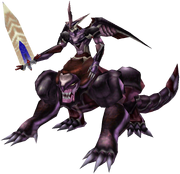Template:Sideicon
The following is list of allusions in Final Fantasy VIII.
Allusions within the series
Final Fantasy series

The Airship models in Mayor Dobe's estate.
- In the residence of Mayor Dobe and Flo in Fishermans Horizon, a number of model aircraft are suspended from the ceiling. They are meant to crudely resemble the Nautilus of Final Fantasy III, the Lunar Whale of Final Fantasy IV, the Blackjack of Final Fantasy VI, and the Tiny Bronco of Final Fantasy VII.
- A recurring trope in the Final Fantasy games prior to Final Fantasy VIII was the presence of pornographic magazines as a novelty item. Final Fantasy VIII continues this trope with The Girl Next Door magazine.
- The chocobo forests allude to the chocobo woods of earlier installments. The first time the player catches a chocobo from a forest is in Final Fantasy II, and it remained as a series's staple with Final Fantasy VII being the only Final Fantasy game between Final Fantasy II and Final Fantasy VIII where the chocobos are not associated with forests.
Final Fantasy
Black Mage in a background.
- In the background in one of the Triple Triad tutorials, the player can spot a Black Mage. Black Mages first appeared in the original Final Fantasy.
- A region of Balamb is named "Gaulg Mountains". This may be an allusion to Mount Gulg.
Final Fantasy II
- Leon's Japanese name, Leonhart, is the surname of Squall. In the Kingdom Hearts series, Squall changes his name to Leon.
Final Fantasy III
- The Great Hyne alludes to Hein from Final Fantasy III.
Final Fantasy IV
- The way the party reaches Bahamut—by fighting two Ruby Dragons before fighting Bahamut himself—bears some similarities to the way Cecil and his party encounter Bahamut in the Red Moon during Final Fantasy IV—by defeating two Behemoths in a row before facing Bahamut.
Final Fantasy V
- The first time a player catches a chocobo from a forest, they are given a chicobo whose default name is "Boko". Boco was Bartz's chocobo in Final Fantasy V.
- Fishermans Horizon and the Horizon Bridge allude to the Island Shrine and the Big Bridge, respectively. It connects two continents in the middle of the world map just as the Big Bridge and Island Shrine do in Final Fantasy V.
- In the Final Fantasy VIII Pocket Station game Chocobo World, Boko meets a girl chocobo called Koko. Koko was Boco's girlfriend in Final Fantasy V.
- If the player chooses the four instruments for the "Irish Jig" at the Garden Festival in Fishermans Horizon, the song played during the concert is the "Town Theme" of Final Fantasy V.
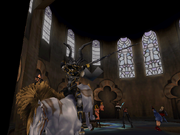
Odin cleaves the party with Zantetsuken.
- The battle against Odin is fought within a time limit. If the party runs out of time during the battle, Odin will use Zantetsuken and end the battle. This is the same in Final Fantasy V. In both games, the timer does not stop when Odin begins his final battle scripts to end the battle, and thus if they run out of time during that time they still lose the battle, although in Final Fantasy VIII this does not mean a Game Over, but merely being ejected from the Centra Ruins.
- Gilgamesh, the passive Guardian Force who replaces Odin, first appeared in Final Fantasy V; this marks the first instance in which he is witnessed successfully traversing dimensions through the Void.
- The Guardian Force Brothers refer to Sekhmet and Minotaur from Final Fantasy V.
- Felling Omega Weapon will net players the Proof of Omega, a trophy item. This tradition was established in Final Fantasy V with the Omega Badge as a reward for beating its Omega, the series's first true superboss.
Final Fantasy VI
- Ultima Weapon first appeared in Final Fantasy VI, though it was mistranslated as Atma Weapon.
- The role of Angelo is similar to that of Interceptor: dogs who assist their respective owner in battle and have a chance of launching counterattacks.
- Despite not being called proper Limit Breaks until Final Fantasy VII, the Desperation Attacks of Final Fantasy VI use an invisible "Crisis Meter" to determine their chance of activation as they do in Final Fantasy VIII.
- Though many of Zell's Duel techniques originate from Final Fantasy VII, they must be implemented with button commands as they were in Final Fantasy VI with Sabin's Blitz arsenal. Specifically, the Meteor Strike was a technique first implemented in Final Fantasy VI, despite several of Zell's other moves having their origin in Tifa's slot Limit.
- The Japanese name for Edea's Limit Break command, called Sorcery in English, is the same term that was translated as "MagiTek" in Final Fantasy VI.
- Siren originates as a summon from Final Fantasy VI, where she also inflicts Silence on enemies when summoned. Coincidentally, summons from Final Fantasy VIII would later be added to Final Fantasy VI's GBA port.
Final Fantasy VII
- Cactuar Island is based on the similar Cactus Island in Final Fantasy VII. The desert areas of the island contain only Cactuers (the standard Cactuar of the game).
- The monster Ultima Weapon wields Cloud Strife's Ultima Weapon sword.
- Several of Zell's Duel abilities are that of hand-to-hand expert Tifa Lockhart, specifically the Dolphin Blow and Final Heaven.
- Zell's Duel ability, Meteor Barret, is named after Barret Wallace.
- The Deep Sea Research Center is a hidden island located in the corner of the world map where the player can obtain the game's strongest GF. Final Fantasy VII had a similar hidden island in the corner of its map that also housed its most powerful individual Summon Materia.
- The various greens available for raising Chocobos in Final Fantasy VII appear as the names of alcoholic beverages in Timber's Aphorora Pub.
- If the player completes all chocobo forests, the chocobos present in the Sanctuary dance and reward the player the chicobo's Triple Triad card. This is a nod to Final Fantasy VII, when dancing chocobos give the player the Choco/Mog Materia at the Chocobo Farm.
- There is a shop in Esthar City named "Cloud's shop", a reference to Final Fantasy VII main protagonist Cloud Strife.
- Squall begins the game with two GFs, Quezacotl and Shiva, who are Lightning and Ice elemental respectively. This may allude to Cloud Strife beginning with two Magic Materia: Lightning and Ice.
- Seifer's attack Bloodfest shares its name with one of Yuffie's Limit Breaks.
- During Eden's summon animation, the Ptolemy celestial diagram floats in space. This is actually taken directly from Safer∙Sephiroth's Supernova animation from Final Fantasy VII. Although likely a reuse of assets, it may also work as an allusion.
Final Fantasy Tactics
- According to the Final Fantasy VIII Ultimania, Triple Triad was created by a psychic named Orlan who modified fortune-telling cards for use in a game.[1] This refers to Orran Durai, who appears in the background in one of the tutorials on the card game.
Allusions to the number eight
Being the eighth installment of the series, Final Fantasy VIII makes some references to the number itself. Although many of these are not necessarily deliberate allusions to the number 8 (whether they are or not is speculative), they are nonetheless present.
- Squall starts at level 7 with his EXP bar half-way filled, similar to how Cloud always levels up in his first battle in Final Fantasy VII. Squall's first level up being from level 7 to level 8 may thus be an allusion to the number 8.
- The maximum possible hits in Squall's Renzokuken is eight.
- The uniform of a regular G-Soldier has the number eight carved on a plate. Their motorcycles are labeled 80a.
- The article that tells SeeDs to report to the nearest Garden in case returning to the assigned Garden is not possible, is in article number eight.
- In Deling City, Rinoa advises the party to take the bus number eight. In fact, all buses in Deling City show that number.
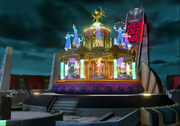
Eight seconds past eight o'clock.
- Edea passes under the archway during her parade at exactly eight o'clock, which was the time for Squall and Irvine to assassinate her.
- Squall's birthday is in August, the eighth month of the year.
- In the D-District Prison, the Galbadian soldiers check out the party's weapons on Floor 8. It is also where Squall saves Zell from the prison warden, and where Rinoa and Irvine reunite with the imprisoned SeeDs.
- During the Battle of the Gardens, those who have student ID numbers ending with an eight have to take care of the junior classmen.
- On the Ragnarok, Squall and Rinoa must defeat eight Propagators before gaining use of the ship.
- There is an enemy called Mobile Type 8.
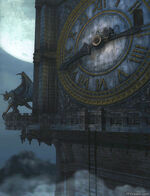
The time shown on the clock tower of Ultimecia's Castle alludes to the number eight.
- On the clock tower in Ultimecia Castle, the hour hand is pointing to "VIII".
- The Information section of the Tutorial menu claims that Centra was destroyed 80 years ago by the Lunar Cry. This is contradicted elsewhere in the game, however.
- Esthar might be a reference to "Ishtar Gate", which was the eighth gate to the inner city of Babylon.
- Shumi Village was built 323 meters beneath the ground. The sum of the numbers (3 + 2 + 3) equals eight.
- When a character uses Devour and the target's HP is higher than the user's, then the command fails and eight points of damage are dealt to the target.
- Ultimecia has eight minions in her castle that must be defeated to unlock the sealed abilities.
- The Doom counter usually starts from 8.
- Not including Laguna, Kiros, and Ward (who are only controlled during the dreams), the game has eight playable characters.
Allusions to other Square games
- Zell's ultimate weapon, Ehrgeiz, refers to the game Ehrgeiz: God Bless the Ring.
Movies
- The full motion video showing the arrival at the Lunar Base is homage to the 1968 film 2001: A Space Odyssey, reminiscent of the "Blue Danube" scene. In place of "The Blue Danube", "Dance with the Balamb Fish" is played. The space station uses centrifugal force to simulate gravity as in 2001. Within the space station, unique camera angles are used, similar to the ones used on the Discovery One by Stanley Kubrick, to show the centrifugal rotation. The long and uninterrupted scene of Rinoa silently floating in space, and the emphasis on the sound of her breathing in her space suit, may also be details inspired by this movie.
Star Wars
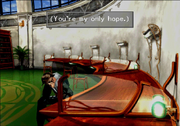
Squall is Ellone's only hope.
- Biggs and Wedge are named after the Star Wars characters Biggs Darklighter and Wedge Antilles, Luke Skywalker's Red Squadron wingmen in Episode IV: A New Hope. Biggs and Wedge are recurring characters in Final Fantasy since Final Fantasy VI.
- Piet is named after Fleet Admiral Firmus Piett, an Imperial officer from the Star Wars movies.
- Martine is named Dodonna in the Japanese, Spanish and German version, and in the Italian version he is called Dodonn. In Star Wars, Dodonna was one of the first generals in the Rebel Alliance.
- At one point Ellone whispers to Squall, "You are my only hope." The line was said by Princess Leia in Episode IV: A New Hope.
- Nida is possibly a nod to the Star Wars character, Captain Lorth Needa.
Music
- The dancers in Edea's parade in Deling City are dancing to the moves of Michael Jackson's "Thriller" music video.
- "Maybe I'm a Lion" is a battle theme that plays during a round in the final battles. Its title may be inspired by the English Hard Rock band Deep Purple's "Maybe I'm a Leo."
Theater
- An NPC female on the platform of Timber's train station mentions "Romeo and Juliet", a play by William Shakespeare.
Religion
- Raijin and Fujin are named after the god of thunders and god of winds in Shinto mythology. Both gods were created by Izanami. In Japanese art, the two deities are often depicted together, most of the time fighting each other.
- Omega Weapon's attack, Megiddo Flame, may refer to the final battle at the end of time in Abrahamic religions, Armageddon. The word itself is based on the mountain of Megiddo in modern-day Israel, where the battle is alleged to take place.
Real world
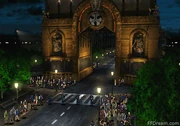
The archway in Deling City.
- "Monterosa Plateau" is the name of an area in Galbadia Continent. Monterosa Massif is the highest massif in the Alps, located in Switzerland and Italy.
- The archway in Deling City is made after the Arc de Triomphe in Paris. Similarly, the Tomb of the Unknown King alludes to the Tomb of the Unknown Soldier, one of them located beneath the Arc de Triomphe.
- The nation of Centra echoes the real world Roman Empire with a reminiscent architectural style. In the world of Final Fantasy VIII Dollet and Esthar were founded by Centra emigrants, the old Dollet being known as Holy Dollet Empire, an allusion the Holy Roman Empire, a weak, fragmented empire of city states proclaimed as a successor to the Roman Empire. The other empire with a claim to being the successor to the Roman Empire is the Byzantine Empire that was more technologically and culturally advanced than the Holy Roman Empire, but also intentionally cut-off and secretive. This reflects Esthar's role in the game.
- The Deep Sea Research Center may allude to the Battleship Island (Gunkanjima in Japanese, alternately called Hashima), a small island near Nagasaki, Japan famous for the abandoned city of Hashima built around a coal mine that went into decline after Japanese power plants switched to using petroleum. Both the real Battleship Island and the one in Final Fantasy VIII house ruined structures.
- Cid Kramer's surname might be taken from Heinrich Kramer, the writer of Malleus Maleficarum (Hammer of the Witch), which lead to Witch Hunt Incident in medieval age.
- Squall's character design was inspired by actor River Phoenix whose birthday is also August 23rd.
- The hotel in Winhill had a map of the real world during Laguna's time period.
Miscellaneous
- The scene at Winhill where the chicobo crosses the road may be an allusion to the age-old joke "Why did the chicken cross the road?"
- The Solomon Ring key item refers to King Solomon, said to have been given a magical ring by the Archangel Michael that allowed him to command demons to do his will. In demonology, these incuded the 72 demons of the Goetia, one of which is Glasya-Labolas, the Japanese name for Doomtrain, the Guardian Force obtained from the ring in Final Fantasy VIII.

